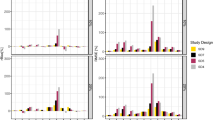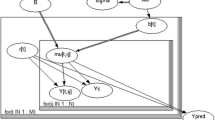Abstract
The impact of assay variability on pharmacokinetic modeling was investigated. Simulated replications (150) of three “individuals” resulted in 450 data sets. A one-compartment model with first-order absorption was simulated. Random assay errors of 10, 20, or 30% were introduced and the ratio of absorption rate (K a )to elimination rate (K e )constants was 2, 10, or 20. The analyst was blinded as to the rate constants chosen for the simulations. Parameter estimates from the sequential method (K e )estimated with log-linear regression followed by estimation of K a and nonlinear regression with various weighting schemes were compared. NONMEM was run on the 9 data sets as well. Assay error caused a sizable number of curves to have apparent multicompartmental distribution or complex absorption kinetic characteristics. Routinely tabulated parameters (maximum concentration, area under the curve, and, to a lesser extent, mean residence time) were consistently overestimated as assay error increased. When K a /K e =2,all methods except NONMEM underestimated K e ,overestimated K a ,and overestimated apparent volume of distribution. These significant biases increased with the magnitude of assay error. With improper weighting, nonlinear regression significantly overestimated K e when K a /K e ,=20. In general, however, the sequential approach was most biased and least precise. Although no interindividual variability was included in the simulations, estimation error caused large standard deviations to be associated with derived parameters, which would be interpreted as interindividual error in a nonsimulation environment. NONMEM, however, acceptably estimated all parameters and variabilities. Routinely applied pharmacokinetic estimation methods do not consistently provide unbiased answers. In the specific case of extended-release drug formulations, there is clearly a possibility that certain estimation methods yield K a and relative bioavailability estimates that would be imprecise and biased.
Similar content being viewed by others
References
W. J. Jusko. Guidelines for collection and analysis of pharmacokinetic data. In W. E. Evans, J. J. Shentag, and W. J. Jusko (eds.),Applied Pharmacokinetics, 2nd ed., Applied Therapeutics, Spokane, WA, 1986, pp. 9–54.
J. G. Wagner. Linear compartment models. InFundamentals of Clinical Pharmacokinetics, Drug Intelligence Publications, Hamilton, IL, 1975, pp. 57–63.
J. G. Wagner and E. Nelson. Per cent absorbed time plots derived from blood level and/or urinary excretion data.J. Pharm. Sci. 52:610–611 (1963).
J. G. Wagner and E. Nelson. Kinetic analysis of blood levels and urinary excretion in the absorptive phase after single doses of drugs.J. Pharm. Sci. 53:1392–1403 (1964).
L. B. Sheiner and S. L. Beal. Pharmacokinetic parameter estimates from several least squares procedures.J. Pharmacokin. Biopharm. 13:185–201 (1985).
C. M. Metzier. Extended least squares (ELS) for pharmacokinetic models.J. Pharm. Sci. 76:565–571 (1987).
E. M. Barcia, J. Newburger, and D. Young. Estimation of the rate constants in a data-sparse environment.J. Pharm. Sci. 77:175–177 (1988).
T. M. Grasela, E. J. Antal, L. Ereshefsky, B. G. Wells, L. Evans, and R. B. Smith. An evaluation of population pharmacokinetics in therapeutic trials. Part II.Clin. Pharmacol. Ther. 42: 433–441 (1987).
J. G. Wagner. Linear compartment models. InFundamentals of Clinical Pharmacokinetics, Drug Intelligence Publications, Hamilton, IL, 1975, pp. 64–65.
SAS User's Guide: Basics, 5th ed., SAS Institute, Cary, NC, 1985, pp. 267–268.
Wagner, J. G. Estimation of theophylline absorption rate by means of the Wagner-Nelson equation.J. Allergy Clin. Immunol. 78:681–688 (1986).
SAS User's Guide: Statistics, 5th ed., SAS Institute, Cary, NC, 1985, pp. 575–606.
M. Gibaldi and D. Perrier.Pharmacokinetics, 2nd ed., Marcel Dekker, New York, 1982, p. 142.
S. L. Beal and L. B. Sheiner.NONMEM User's Guide-Part I: User's Basic Guide, Technical Report of the Division of Clinical Pharmacology, University of California, San Francisco, 1980.
S. L. Beal, A. J. Boekmann, and L. B. Sheiner.NONMEM User's Guide-Part VI: PREDPP Guide, Technical Report of the Division of Clinical Pharmacology, University of California, San Francisco, 1985.
L. B. Sheiner and S. L. Beal. Some suggestions for measuring predictive performance.J. Pharmacokin. Biopharm. 9:503–512 (1981).
J. G. Leferink, W. VandenBerg, I. Wagemaker-Engels, J. Kreukniet, and R. A. A. Maes. Pharmacokinetics of terbutaline, a beta-2-sympathomimetic, in healthy volunteers and asthmatic patients.Arzneim. Forsch. 32:159–164 (1982).
L. Aarons. Assessment of absorption in bioequivalence studies.J. Pharm. Sci. 76:853–855 (1987).
W. Reiss, S. Brechbuhler, P. H. Degen, W. Dieterle, G. Dorhofer, and K. F. Feldman. Estimation of the individual metabolic state and its consideration in optimal pharmacotherapy.Int. J. Clin. Pharmacol. Res. 3:495–510 (1983).
A. L. Boner, D. Bennati, E. A. Valletta, M. Plebani, M. T. Stevens, and J. C. V. Scott. Evaluation of food on the absorption of sustained-release theophylline and comparison of two methods for serum theophylline analysis.J. Clin. Pharmacol. 26:638–642 (1986).
M. Lagas and J. H. G. Jonkman. Greatly enhanced bioavailability of theophylline on postprandial administration of a sustained release tablet.Eur. J. Clin. Pharmacol. 24:761–767 (1983).
L. Nyberg and B-M. Kennedy. Pharmacokinetics of terbutaline given in slow release tablets.Eur. J. Resp. Dis.,65:119–139 (1984).
D. P. Thornhill. Pharmacokinetics of ordinary and sustained-release lithium carbonate in manic patients after acute dosage.Eur. J. Clin. Pharmacol. 14:267–271 (1978).
D. R. Mungall, T. M. Ludden, J. Marshall, D. S. Hawkins, R. L. Talbert, and M. H. Crawford. Population pharmacokinetics of racemic warfarin in adult patients.J. Pharmacokin. Biopharm. 13:213–227 (1985).
D. A. Graves. Failure of single-dose kinetics to predict steady state.Drug Intell. Clin. Pharm. 22:917–918 (1988).
C. L. Peck, S. L. Beal, L. B. Sheiner, and A. I. Nichols. Extended least squares nonlinear regression: A possible solution to the “choice of weights” problem in the analysis of individual pharmacokinetic data.J. Pharmacokin. Biopharm. 12: 545–558 (1984).
L. B. Sheiner and S. L. Beal. Evaluation of methods for estimating population pharmacokinetic parameters III. Monoexponential model: Routine clinical pharmacokinetic data.J. Pharmacokin. Biopharm. 11:303–319 (1983).
L. B. Sheiner and S. L. Beal. Evaluation of methods for estimating population pharmacokinetic parameters II. Biexponential model and experimental pharmacokinetic data.J. Pharmacokin. Biopharm. 9:631–651 (1981).
Author information
Authors and Affiliations
Rights and permissions
About this article
Cite this article
Graves, D.A., Locke, C.S., Muir, K.T. et al. The influence of assay variability on pharmacokinetic parameter estimation. Journal of Pharmacokinetics and Biopharmaceutics 17, 571–592 (1989). https://doi.org/10.1007/BF01071350
Received:
Revised:
Published:
Issue Date:
DOI: https://doi.org/10.1007/BF01071350




